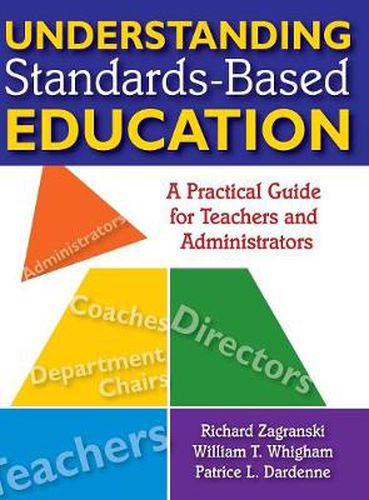Readings Newsletter
Become a Readings Member to make your shopping experience even easier.
Sign in or sign up for free!
You’re not far away from qualifying for FREE standard shipping within Australia
You’ve qualified for FREE standard shipping within Australia
The cart is loading…






This comprehensive guide to standards-based education takes a collaborative and respectful stance toward teaching, learning, and accountability that both incorporates and looks beyond No Child Left Behind. Grounded in the authors’ pyramid of responsibility, Understanding Standards-Based Education identifies what everyone needs to know about standards-based education, what ‘most’ stakeholders need to know, and what only ‘some’ stakeholders need to know. The authors focuses on clarifying role responsibilities and then invites effective participation by all. Among the core stakeholder-participants in the authors’ system of standards-based education and accountability are students, parents, and teachers (level 1); team leaders, department chairs, and facilitators of standards-based curriculum (level 2); and principals, superintendents, and school boards//oversight committees (level 3).This invaluable resource includes: - An overview of NCLB legislation highlighting current areas of concern for all three stakeholder levels - A data-driven plan of action and assessment for transforming the traditional educational curriculum into a standards-based curriculum - Clear step-by-step instructions in every chapter to ensure sustainability of the standards-based system - The book’s instructional approach incorporates best practices from direct instruction (Madeline Hunter), brain-based learning, differentiated instruction, and other core teaching methods as well as formative and summative student assessment techniques. - Each chapter features ready-to-use templates, charts, rubrics, and checklists for stakeholders at each of the three levels of responsibility. Filled with the authors’ wealth of hands-on experience, this teacher-friendly text is ideal for teachers, curriculum planners, and instructional leaders.
$9.00 standard shipping within Australia
FREE standard shipping within Australia for orders over $100.00
Express & International shipping calculated at checkout
This comprehensive guide to standards-based education takes a collaborative and respectful stance toward teaching, learning, and accountability that both incorporates and looks beyond No Child Left Behind. Grounded in the authors’ pyramid of responsibility, Understanding Standards-Based Education identifies what everyone needs to know about standards-based education, what ‘most’ stakeholders need to know, and what only ‘some’ stakeholders need to know. The authors focuses on clarifying role responsibilities and then invites effective participation by all. Among the core stakeholder-participants in the authors’ system of standards-based education and accountability are students, parents, and teachers (level 1); team leaders, department chairs, and facilitators of standards-based curriculum (level 2); and principals, superintendents, and school boards//oversight committees (level 3).This invaluable resource includes: - An overview of NCLB legislation highlighting current areas of concern for all three stakeholder levels - A data-driven plan of action and assessment for transforming the traditional educational curriculum into a standards-based curriculum - Clear step-by-step instructions in every chapter to ensure sustainability of the standards-based system - The book’s instructional approach incorporates best practices from direct instruction (Madeline Hunter), brain-based learning, differentiated instruction, and other core teaching methods as well as formative and summative student assessment techniques. - Each chapter features ready-to-use templates, charts, rubrics, and checklists for stakeholders at each of the three levels of responsibility. Filled with the authors’ wealth of hands-on experience, this teacher-friendly text is ideal for teachers, curriculum planners, and instructional leaders.